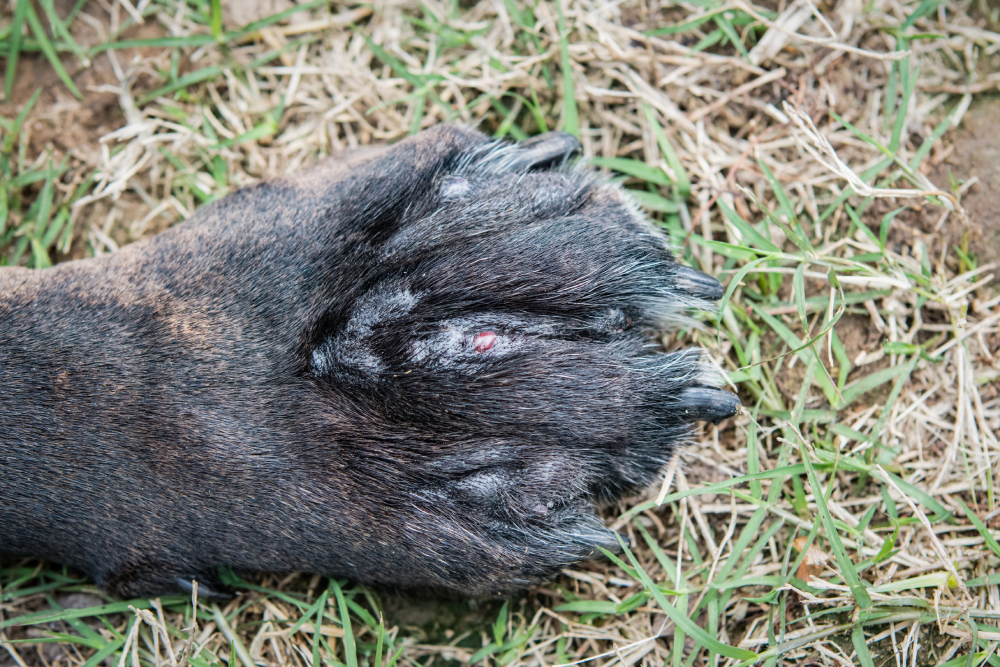We think you’re so lucky to own a Pitbull! Unfortunately, these outgoing and loyal companions often struggle with skin problems. Is your Pitbull itchy? Do they have bald patches, also known as alopecia? Is their skin red and inflamed, indicating dermatitis?
You’re not alone in your struggles. While listing every possible skin complaint in one article is impossible, we have 10 plausible conditions and treatment advice for you.


The 10 Common Pitbull Skin Issues
1. Atopic Dermatitis
Atopic dermatitis is very common and is a type of allergy to airborne particles. Allergens are substances that can cause allergies, and in the case of atopic dermatitis, the allergen can be pollen, dust mites, molds, or mildew, for example.
Depending on the allergen, the allergy can occur seasonally or year-round. Atopic dermatitis is also a problem with the skin barrier. Think of these dogs as having “leaky” skin, which lets in the allergens. Atopy generally starts in young adulthood and affected dogs can be itchy all over, especially around the face, eyes, paws, and armpits.
Treatment: Medications are often needed to control itching and secondary infections. A specialist can perform allergy testing and immunotherapy to desensitize your dog to the allergens. Special diets or supplements are often helpful in reducing the severity of dermatitis.
For example, Royal Canin Veterinary Diet Adult Skin Support Dry Dog Food contains nutrients to promote a healthy skin barrier, as well as anti-inflammatory ingredients like omega-3 fatty acids and turmeric.


2. Food Allergies
Food allergies are a reaction to something your dog is eating. The most common food allergies are protein allergies to beef, chicken, lamb, eggs, dairy products, or soy. Aside from itchy skin and recurrent ear infections, food allergies can sometimes also cause vomiting and diarrhea.
To diagnose a food allergy, an elimination diet trial is performed. Essentially, the diet is restricted to a protein source that has been hydrolyzed or is unfamiliar to your dog to minimize the immune response. If there is an improvement in 8–12 weeks, a food allergy can be diagnosed. The elimination diet requires strict compliance from everyone around the dog. Any treats that do not comply with the diet will interfere with the results. Your veterinarian will then advise you on reintroducing foods to determine the cause of the allergy.
Treatment: Once you know what your dog is allergic to, avoiding foods and treats with those ingredients is relatively easy. You must check the ingredients list of any food, treat, or supplement you purchase to ensure it doesn’t trigger your dog’s food allergies.
Keep in mind that chewable tablet medications, like flea and tick products, can contain proteins that may trigger food allergies in some dogs.
3. Contact Allergies
Contact allergies are reactions to things your dog’s skin comes into contact with. A typical example is a grass allergy that causes dermatitis on the hairless abdomen, armpits, and between the paw pads. Materials like wool, synthetics, other plants, and chemicals can cause contact dermatitis.
Finding the source of the allergy can take some time. If you think your dog has a contact allergy, be observant about what triggers their signs. Veterinary dermatologists can also perform allergy testing to determine what triggers your dog’s dermatitis.
Treatment: The best way to treat contact allergies is to avoid the allergens responsible for the problem, but that is not always known or possible. Minor irritations can be treated with a soothing shampoo.
Colloidal oatmeal is good for inflamed skin. In more severe cases, your vet may prescribe creams or medication to soothe the irritation when it flares up. Some over-the-counter antihistamines are safe for dogs, but they aren’t always very effective.

